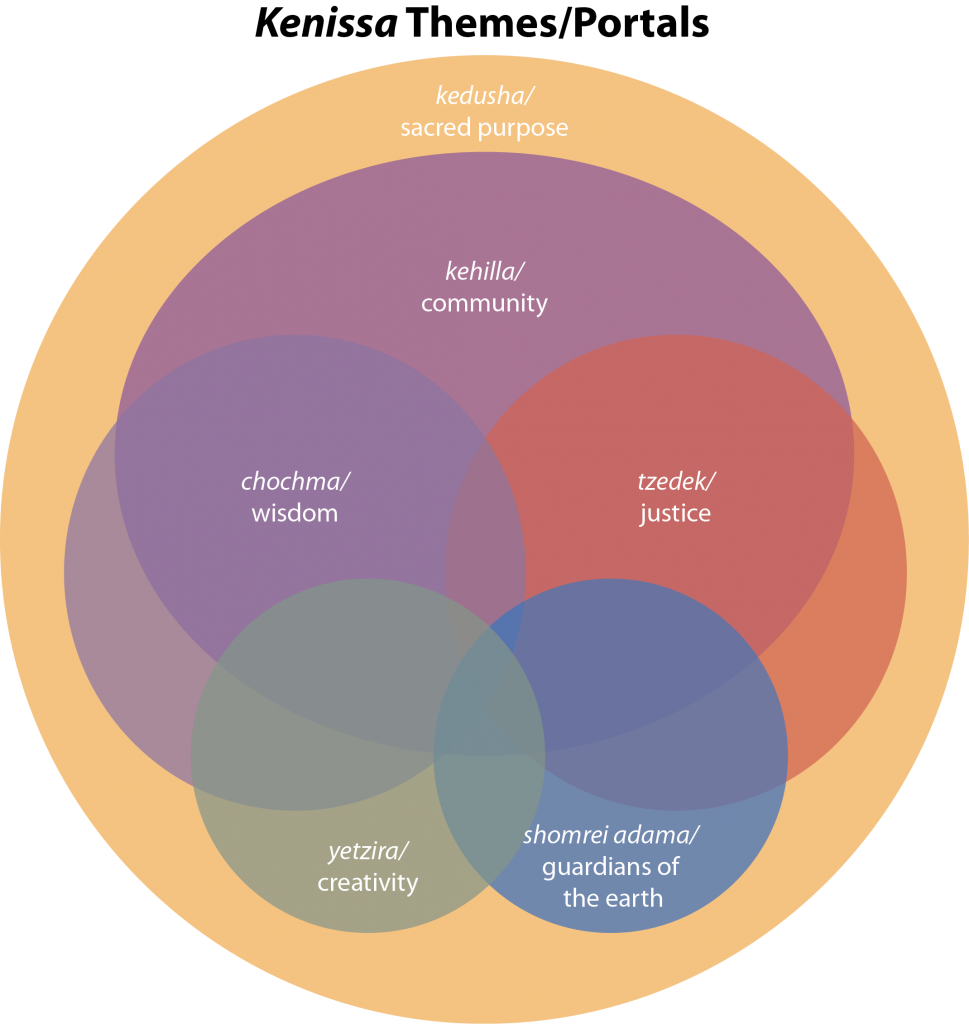The conceptual framework for the Kenissa initiative comes from the theme essay from Rabbi Sid Schwarz’s book, Jewish Megatrends: Charting the Course of the American Jewish Future. In that essay Schwarz argues that any organization that hopes to speak to the next generation of American Jews needs to advance one or more of four key value propositions. They are:
- Kehilla/Covenantal Community: Intentional social arrangements in which people enter into mutual obligatory relationships, committed to a common mission and to each other.
- Chochma/Wisdom: Applying the teachings and practices of one’s inherited religious and cultural tradition to give greater meaning to life.
- Tzedek/Social Justice: The impulse to work for greater peace and justice, especially for the most vulnerable in the world.
- Kedusha/Sacred Purpose: Finding one’s sacred purpose in life or life’s vocation.
This framework has constantly evolved since the launch of the Kenissa initiative in 2015. As people were invited to attend the National Kenissa Consultations and join the Kenissa Network, they were invited to write responses to Rabbi Sid’s essay, indicating what they agreed with, what they disagreed with and what they think the essay might have missed. Those short essays became the content for a weekly Kenissa blog, with hundreds of essays, offering unique perspectives on the future of American Jewish life.
At the first National Consultation of the Kenissa initiative in March 2016 a fifth value proposition was added based on feedback from the participants. That value was:
- Yetzira/Creativity: The human ability to imagine/invent/create ideas, science, art and culture.
By the fifth National Consultation, in 2020, a sixth value was added:
- Shomrei Adama/Guardians of the Earth: Pursuing a lifestyle that is ecologically responsible and sustainable, including new communal living arrangements.
At national Kenissa gatherings, the Venn diagram below, has been the trigger for fascinating conversations about the nature of Jewish community and Jewish life. Increasingly, the value propositions came to be discussed as themes or “portals”, representing the doorways through which Jews might enter into Jewish life. That is how the project came to be called Kenissa, the Hebrew word for “entrance-way”.
The graphic was used the way Jews often use sacred texts. It has excited peoples’ imaginations and invited all manner of commentary. As such, the Venn diagram itself, has gone through multiple permutations. Not only have two themes been added since the early days of Kenissa, but we began to do an exercise in which participants at our Consultations were invited to create their own graphic representations of Jewish life. You can find a sampling of those graphics below, accompanied by the “author’s name” and the commentary they wrote to accompany their graphic.
The process has been at least as important as the product. From its inception, the Kenissa initiative has believed that individual Jewish creativity must be encouraged and validated. The age when the design of the Jewish community was created by a handful of elites is over. We now live in an age of open-sourced, networked wisdom when ideas matter. Let a thousand flowers bloom. Each of the hundreds of organizations in the Kenissa Network represent a unique vision of what makes Jewish life “sacred”. Each has the potential to attract a constituency. Each is part of the unfolding beauty and depth of the Jewish tradition. And that is to be celebrated.
2020 Gallery of graphic representations of North American Jewish life by Kenissa Network members
Scroll forward to see all of the diagrams
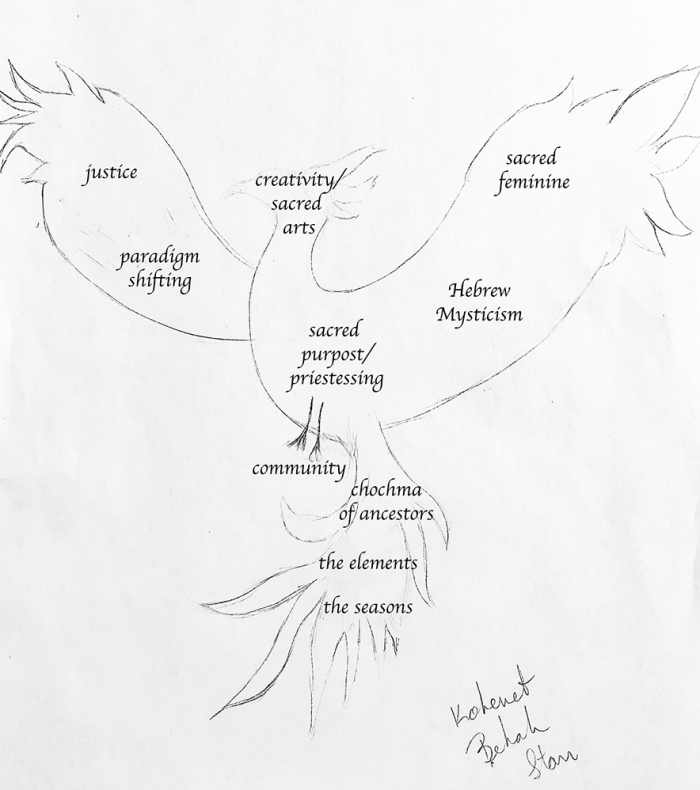
Kohenet Bekah Starr
Bekah Starr Art
Beacon, NY
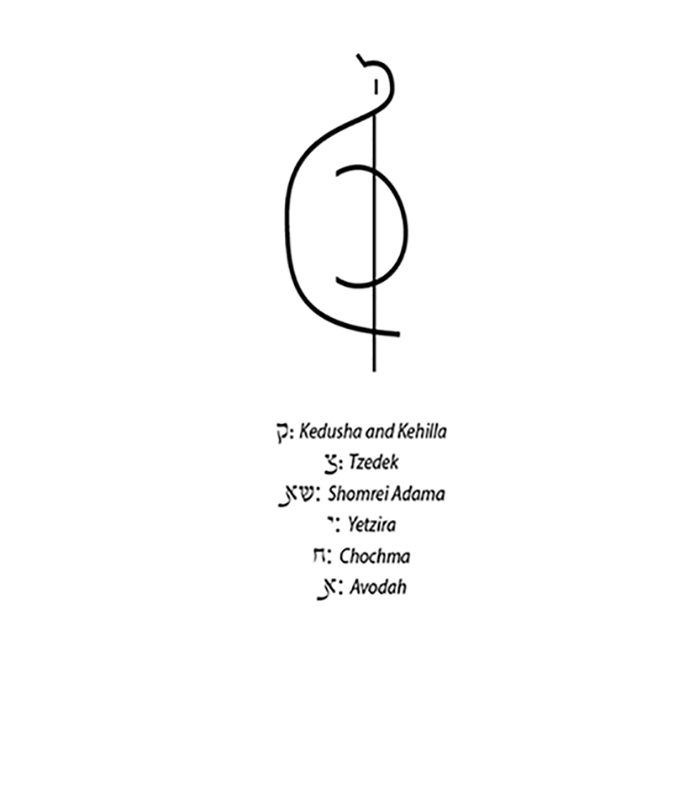
Kohenet Ketzirah Lesser
Devotaj Sacred Arts
Washington, DC
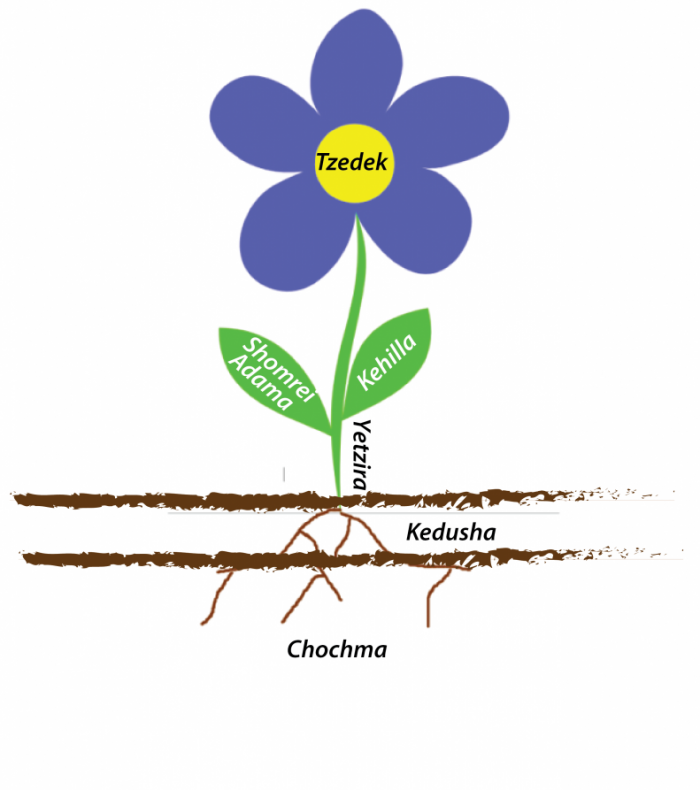
Rabbi Justin Goldstein
Yesod Farm and Kitchen
Asheville, NC
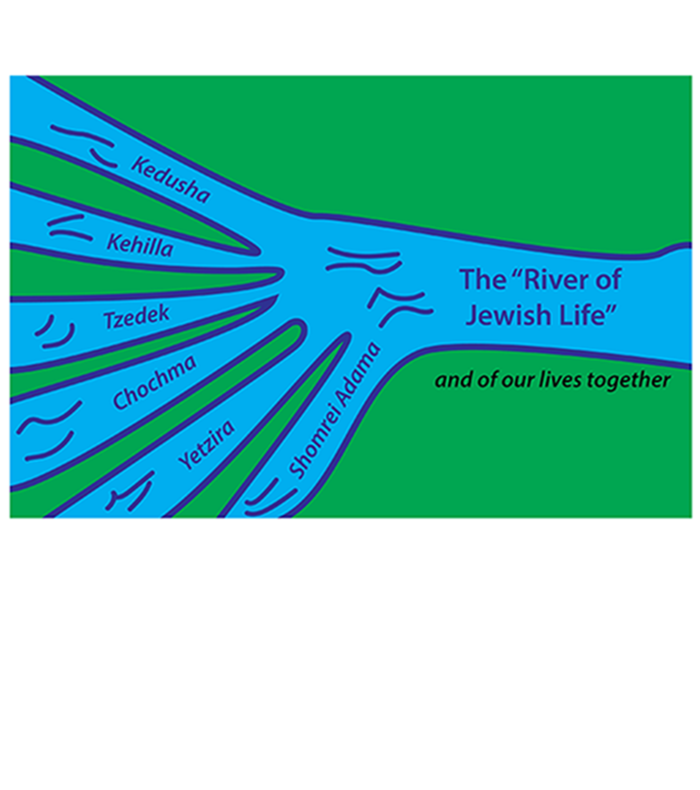
Stuart Himmelfarb
B3/The Jewish Boomer Platform
New York, NY
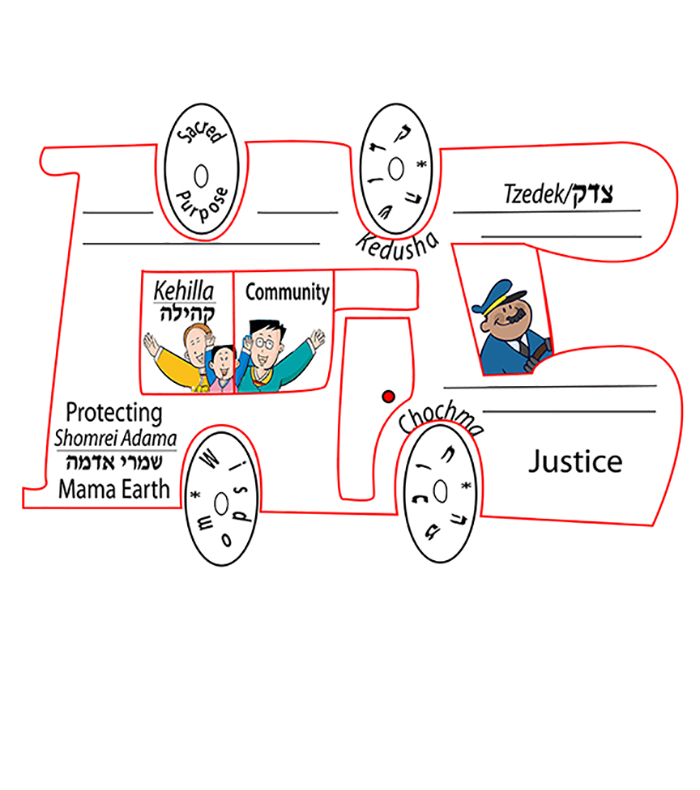
Rabbi Jessy Dressin
Repair the World-Baltimore
Baltimore, MD
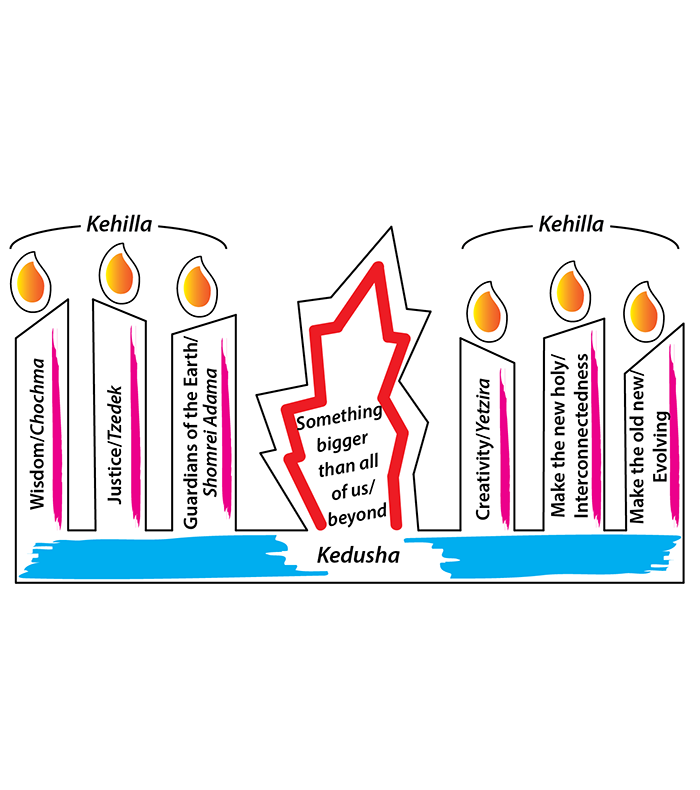
Danielle Levsky
Artist/writer/performer
Chicago, IL
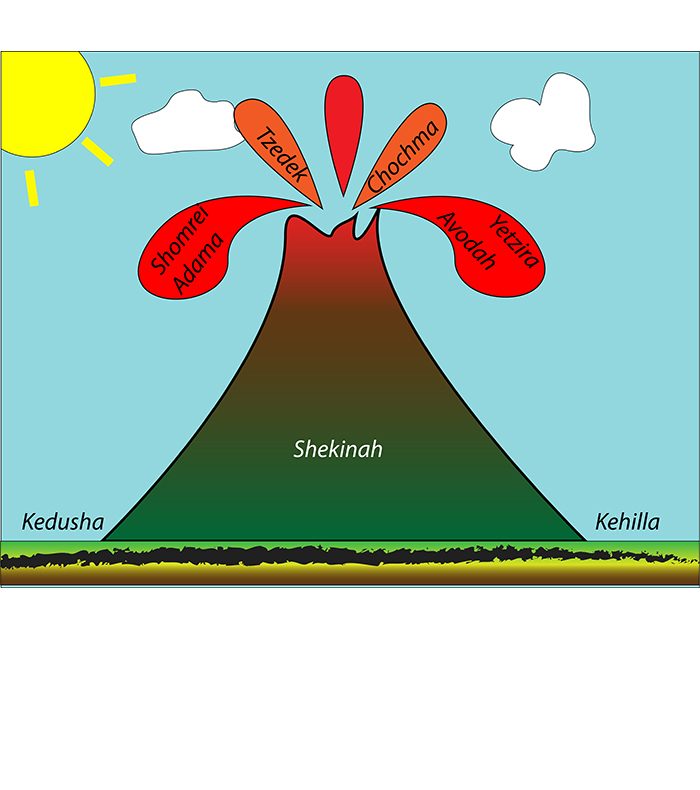
Rabbi Rachel Short
Ahava Aina Community
Hilo, Hawaii
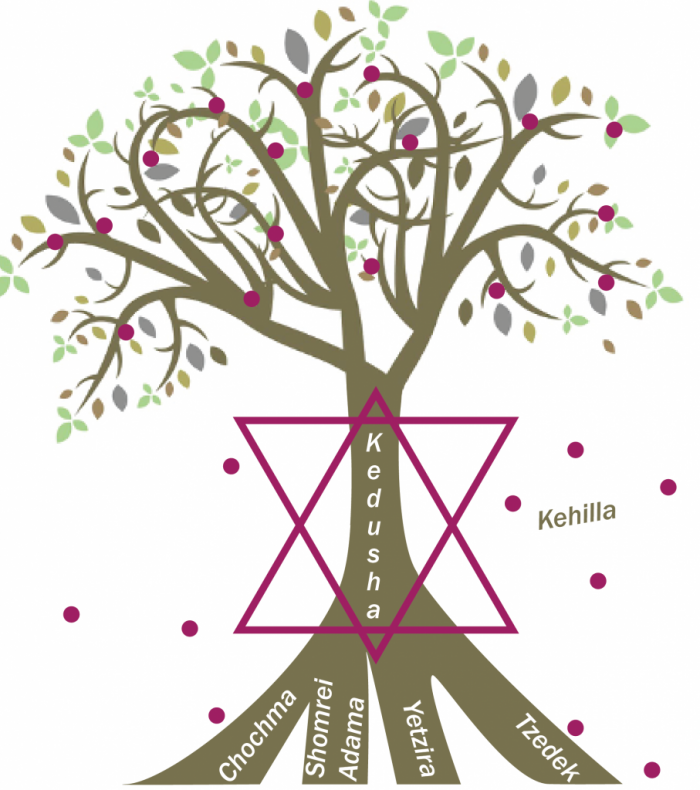
Rachel Weinstein White
Fig Tree
Brooklyn, NY

Arielle Aronoff, Hazon, Falls Village, CT
Rabbi Jessy Dressin, Repair the World-Baltimore, Baltimore, MD
Rabbi Sarah Tasman, The Tasman Center for Jewish Creativity, Silver Spring, MD
2019 Gallery of graphic representations of North American Jewish life by Kenissa Network members
Scroll forward to see all of the diagrams
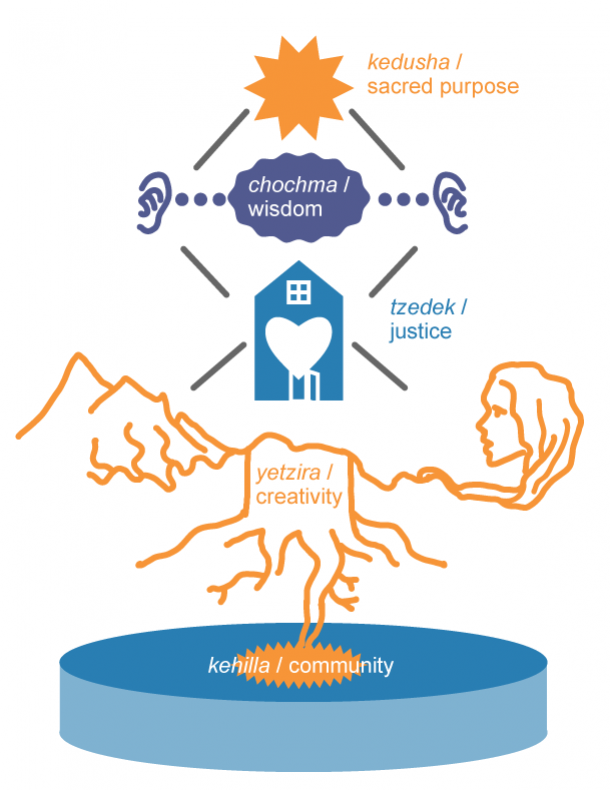
In mapping the Kenissa themes/portals onto the tree of life I was connecting the ancient maps of the universe to the emerging maps. I see the portals not as entry points into new forms of how Jews are gathering so much as qualities and archetypal energies in intricate interplay with each other that we draw from in order to create our temples, minyanim, sanctuaries, programs, life, relationships, etc. They are the roots, the underpinnings, without which the visible world is not possible.
David Bronstein
Taproot
Burlingame, CA
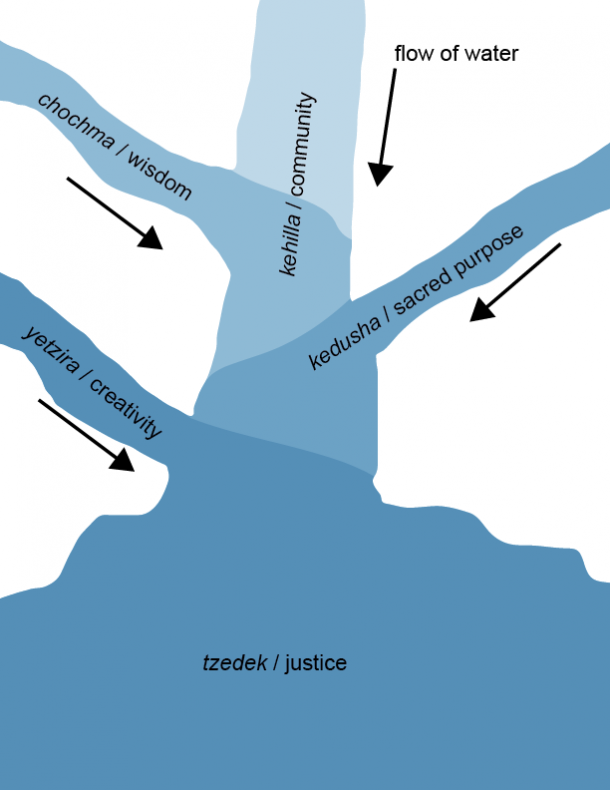
The Jewish Community/Kehilla is a river that we are all floating on together, and is strengthened by the streams that feed it. Chochma/Wisdom are the teachings of our ancestors, and the stories that give us foundation and a common narrative. Kedusha/Sacred Purpose feeds our communal river with our individual and collective dreams. Yetzira/Creativity joins to let our ideas swirl together and be unafraid of the future and uncharted waters. Finally, if we allow all of these elements to be a part of our communal flow, we reach towards Tzedek/Justice.
Andrew Davies
The Bible Players/Charactours
Philadelphia, PA
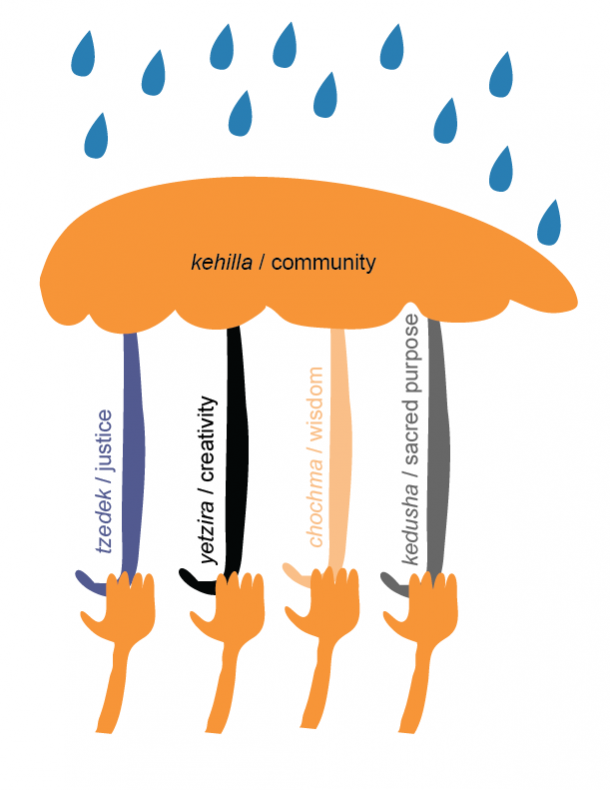
Community is the umbrella under which all of our work exists: justice, creativity, wisdom, sacred purpose. Each hand holds up a part the community, rather than doing that work alone, the work feeds into the greater good. If one handle is missing, the community is not complete. The community is stronger with all handles present, everyone doing what they feel called to do, and doing it well, rather than trying to do it all.
Sara Fatell
One Table
Washington D.C.
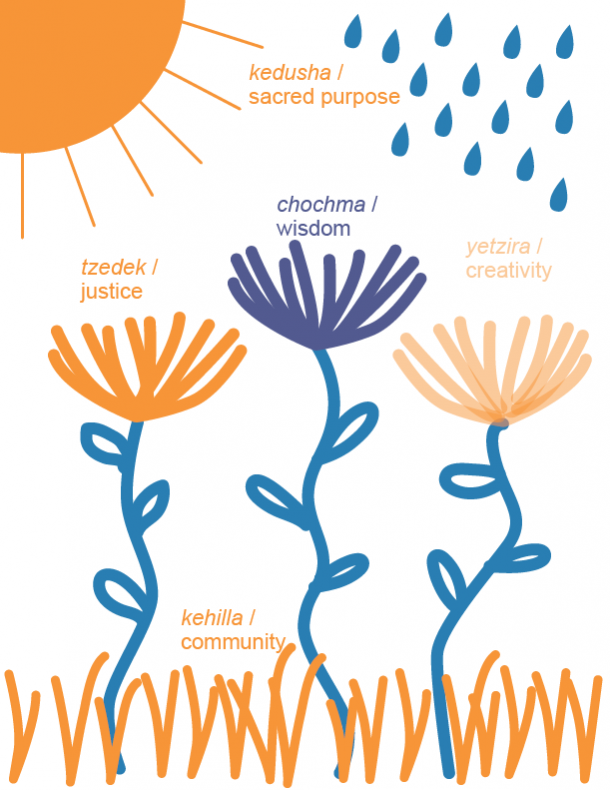
The metaphor I use for representing the various aspects of Jewish life is a garden. Being a community of meaning entails building a strong foundation of kehilla which encourages us to be bound up with one another, in times of joy and hardship, and in the everyday too. The strength of the relationships that we form is what creates the fertile ground of trust, mutual interest and capacity for various values to root deeply. With that solid ground beneath us, and with a sense of kedusha raining down and nourishing us (collectively and individually), we can plant seeds of chochma, tzedek and yetzira and enjoy their flourishing. As they grow, they will remind us that all living things (people and organizations included) are dynamic, cyclical and seasonal.
Keshira haLev Fife
Kesher Pittsburgh
Pittsburgh, PA
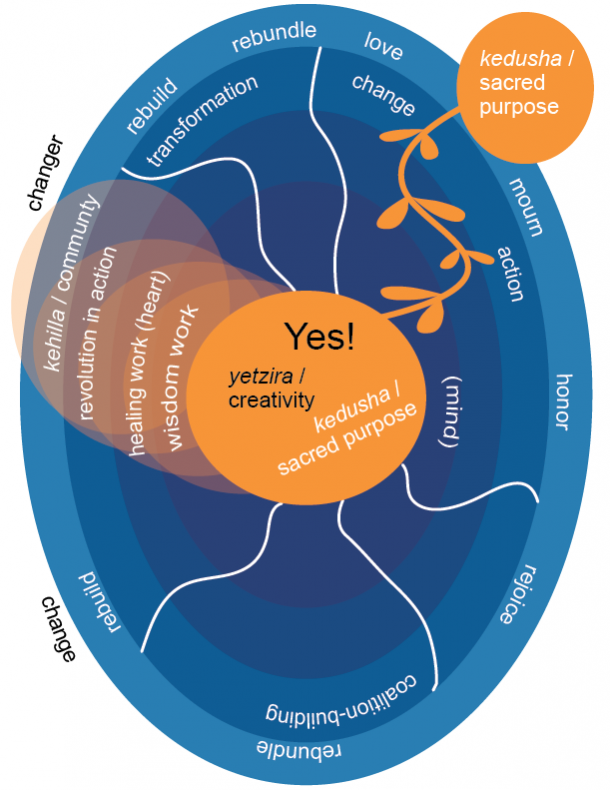
In this graphic, sacred purpose infuses our work from within and from without. As changer and changed, we are the keepers and guardians of both sacred space and community. Surrounding the creativity from which all life comes, are the spheres of wisdom, healing, action, and community. They are nested in this way to suggest that sustainable and revolutionary relationships and community where there is no ’other’ are only possible when rooted in and woven together by our shared purpose (dismantling oppression and restoring our senses of connectedness), the wisdom from our lives and lineages, our brave commitment to personal and collective healing and transformation, and our need to hold and be held in the fullness of who we are. The survival of our communities and ourselves depends on shifting from being driven by fear to being driven by love.
Rinah Rachel Galper
Our Sacred Circles
Durham, NC
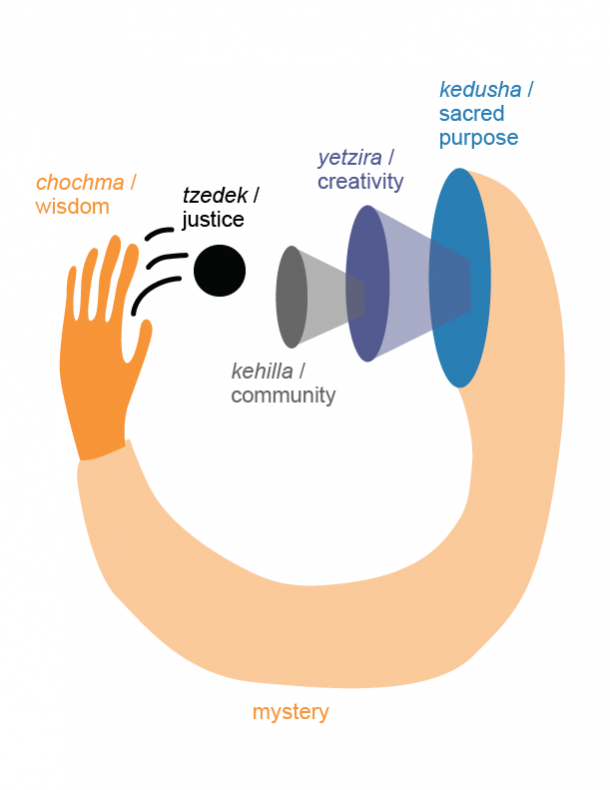
When I began my drawing, all that I knew clearly was that justice was the central and most constant aspect of what we are doing with CONNECT, the organization that I work with in Washington, DC. It is both the goal, and the vehicle. I began to explore how community, creativity, and sacred purpose might be in relationship to one another and to justice. What emerged was a set of portals that informed one another, contributing to incremental growth. As we work with – and toward – justice, our work creates community. Through community, we are more able to innovate, take risks, and access personal and collective creativity. Through creativity, we are connected to our sacred purpose. And when we engage with sacred purpose, we are introduced to mystery. People often conflate creativity, sacred purpose, and mystery. They are layers of the same process, but they are separate layers that we connect to incrementally. As we learn to surrender to and learn from mystery, we develop wisdom. And like all growth, this process is cyclical. From a place of deeper wisdom, we are inclined to act in justice, to send justice through each portal that we can. In doing so we begin again, growing stronger, more resilient and impactful with each trip around the cycle.
Mo Golden
Minyan of Thinkers
Washington D.C.
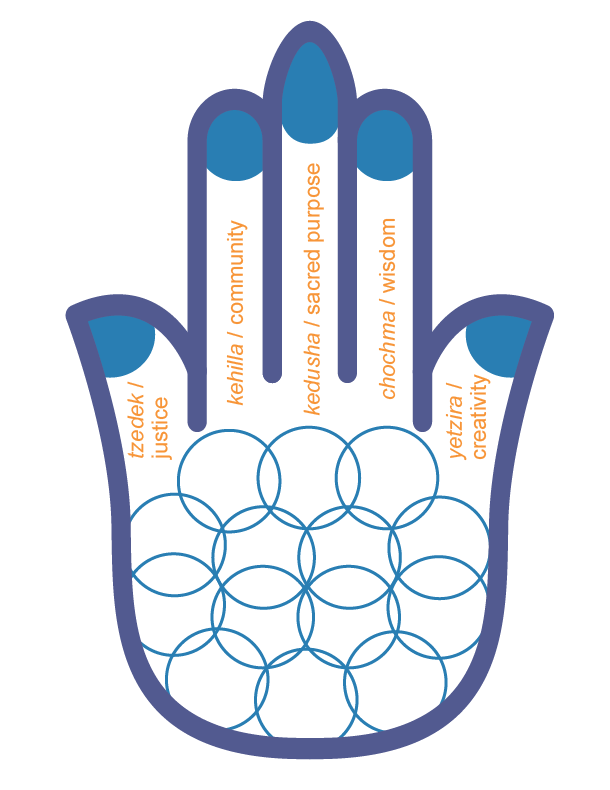
What will undoubtedly be familiar to many people – the hamsa – immediately came to mind when thinking of the five Kenissa themes. Also known as the Hand of Miriam/Mary/Fatimah/Goddess, the resonance of the hamsa crosses cultures and religions, just as these five themes can be found through, across, and outside of the Jewish community. Representing blessings, power, strength, and protection, the fingers of the hand are touching, indicating the closeness of the themes. Together, they are more than the sum of their parts.
Caroline Kessler
Ashreinu
St. Louis, MO
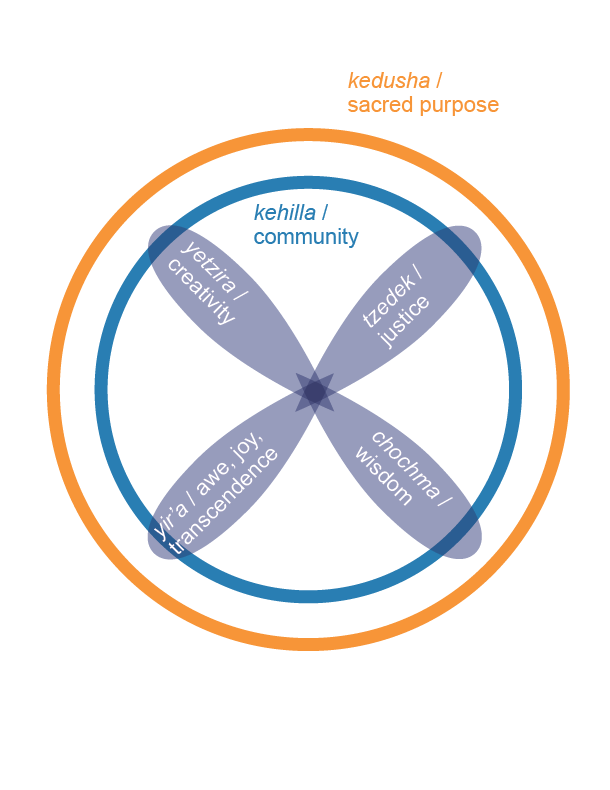
Pathways of kedusha (holiness) and kehilla (holy community) are timeless and ever changing. Mishnah recorded that the world stands on Torah, avodah and gemilut chasadim (Avot 1:2). Today we might render these as chochma (wisdom), yetzira yetzira (self-transcending creativity) and tzedaka (justice).
All three shape any sustainable Jewish community worth building. To be sure, some manifestations do not effectively build community: they might flow outside community or undermine community. Some world wisdom advocates asceticism or nihilism; some creativity confounds or excludes; some justice impulses are excessive.
Thus, a Venn diagram for these attributes should extend beyond the borders of kehilla. We might extend them even beyond kedusha, reflecting that any path can become a byway of spiritual bypassing rather than spirituality.
To these three attributes I add a fourth for the emotional realm. As the Sfat Emet teaches, all sacred paths ultimately seek to align the heart with the sacred. I render this felt sense as yir’ah (awe); it also might evoke joy, love, wonder or transcendence.
Yir’ah is key to any community-building model. Like other building blocks, yir’ah both overlaps and stands independent of the others. Likewise, because it can both build and undermine kehillah, its Venn boundaries must reach beyond kehillah itself.
The ”ideal” is for chochma, yetzira, tzedaka and yir’ah to balance and mutually reinforce each other in an infinitely generative center.
Rabbi David Evan Markus
Temple Beth El
City Island, NY
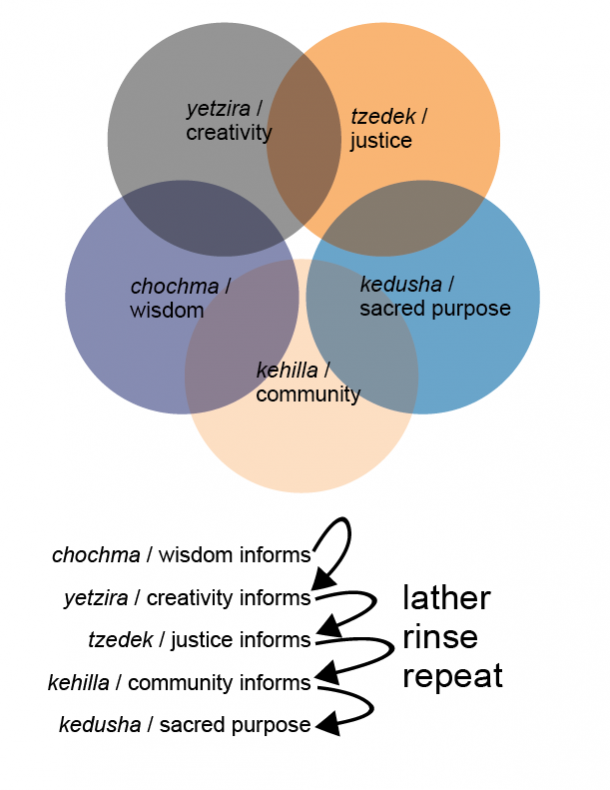
The themes are all both interchangeable and inextricably linked to one another. Each one informs the next and then the end result returns back to the ”beginning,” which to me meant the wisdom and tradition that we’ve been fortunate to inherit from our ancestors. Creation stems from that wisdom and tradition, is then filtered through the lens of justice to form community and ultimately, remind us of our sacred purpose – which then helps to fuel the continuity of the wisdom and tradition and so on ad infinitum.
Libby Parker
Jewfolk
Minneapolis, MN
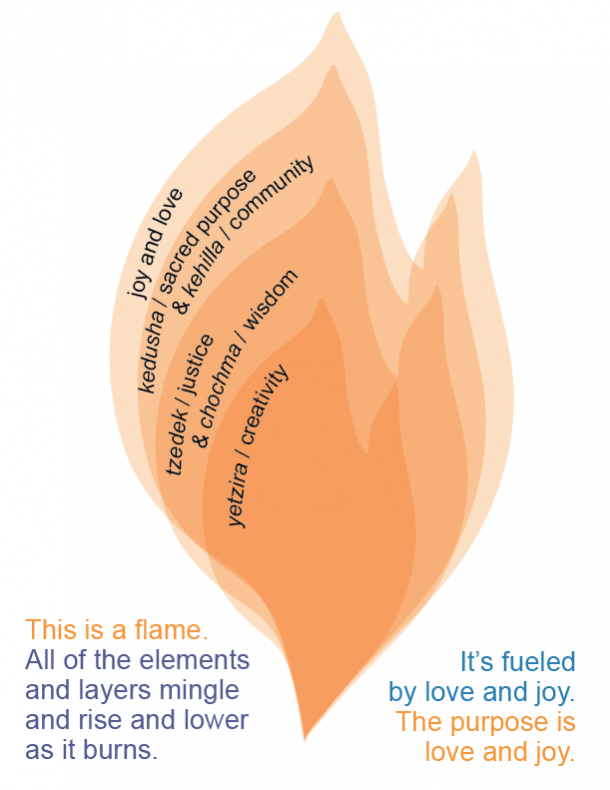
Jewish life should promote an environment filled with and fueled by love and joy. The other four elements are tended to, cultivated, nurtured and nourished simultaneously through love and joy. Different elements will receive greater focus or tending depending on the experience/opportunity being developed/provided. Jewish life is portrayed as a flame – rising up – raising up the self and the other. We are rising as individuals and as part of collective. We raise up ourselves through love and joy. We raise up the other through love and joy. Jewish community is a platform for providing humanity to human beings.
Rabbi Laurie Phillips
Beineinu
New York, NY
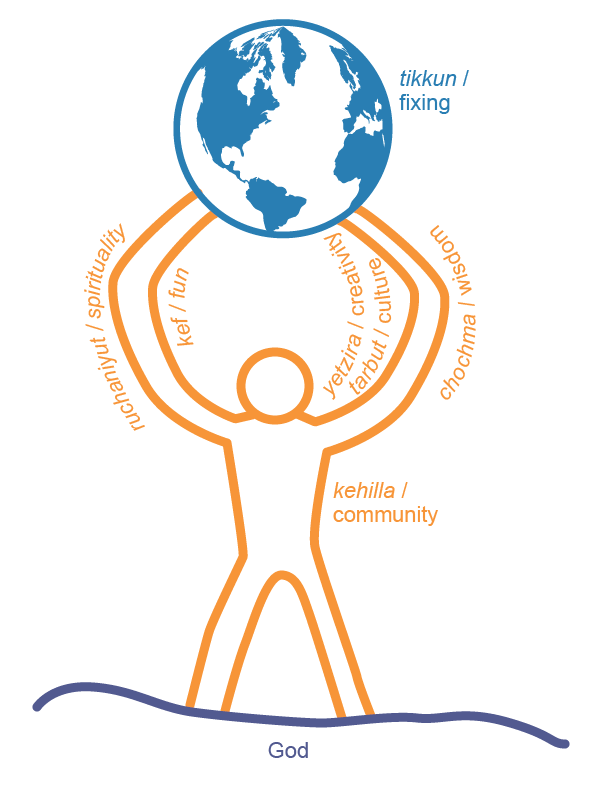
My diagram illustrates that the ground of our existence is the Divine, the Eternal Source. Our task is to engage with the world to effect tikkun, which I might define as realizing more of the world’s divine potential. The “body” that enables that work, and connects its various aspects is kehilla/community. Although individuals do important work, it is always based in community or enabled by community in some way. I’ve used the arms to show the variety of means that we might use to effect tikkun: ruhaniyut/spirituality; kef/fun; yetzira-tarbut/creativity-culture, and chochma/wisdom. When I drew this, I was thinking that tzedek/justice is such an integral part of tikkun that it didn’t need to be labeled on the arms, but now I might add it. Different groups in the Kenissa ecosystem might emphasize different tools, but they all are grounded in The Source, all accomplish tikkun, and all use one or more of the ‘tools’ that I’ve listed.
Rabbi Jeremy Schwartz
Bnai Israel Community
Williamantic, CT
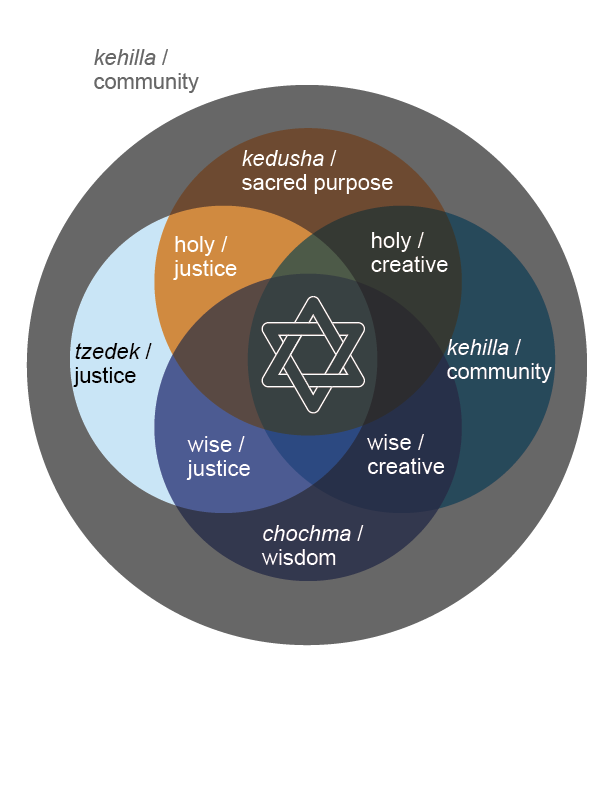
At its heart, a Venn diagram shows intersections. But even when they are pictured visually, the combinations of intersections aren’t often named. I wanted to name each different combination of emerging trends to articulate more fully the ways in which innovative communities are intertwining interests and priorities to create opportunities that transcend any one circle or idea. All of these ideas are encircled by kehilla because creating community is the driving force and the main reason behind any of these combinations of approaches. It doesn’t matter how people approach Judaism or what combinations of interests motivate them to pursue Jewish life; what matters most is that a wide variety of intersections are available and are included in the concept of community.
Miriam Steinberg-Egath, Center City Kehillah, Philadelphia, PA
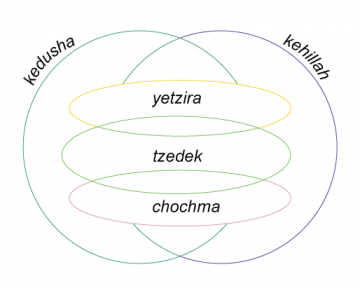
As a spiritual community we are supposed to be a kehillah kedoshah. This diagram gives equal prominence to kehillah and kedusha, with lots of overlap but some not. They mutually reinforce each other, and each needs the other. As an halachic, egalitarian congregation for people of all gender identities and sexual orientations, our egalitarian ideals (tzedek) interact with the wisdom of our tradition (chochma) and the creativity of our lived lives (yetzira), and all of these three influence one another and fuel the sacred fire at the heart of a spiritually alive community.
Rabbi Guy Austrian
Fort Tyron Jewish Center
Washington Heights, NY
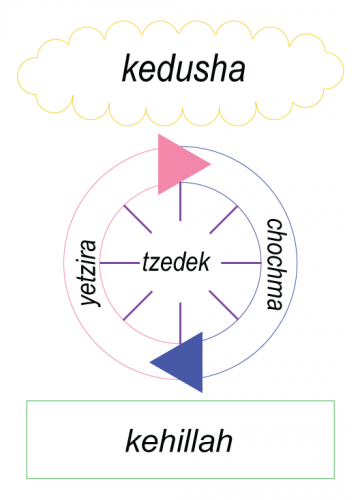
In my Venn, the community (kehillah) is the level of reality and of people, represented by a rectangle (which could stand for a communal building, or home, or other real structure). Holiness (kedusha), is represented by a cloud above the community. It is the level of spiritual potential toward which the community aspires. Then, there is a never-ending cycle which exists to connect the people’s reality to the aspired spiritual potential and back again. Wisdom (chochma) comes from the holy tradition and comes down to the level of the community. Creativity (yetzira) comes up from the community and becomes holy. This cycle between wisdom and creativity feeds on itself, on the real people and on holiness. Finally, justice (tzedek) is the cog in the middle of the wheel which holds it together and centers it.
Deborah Fishman
FED
New York, NY
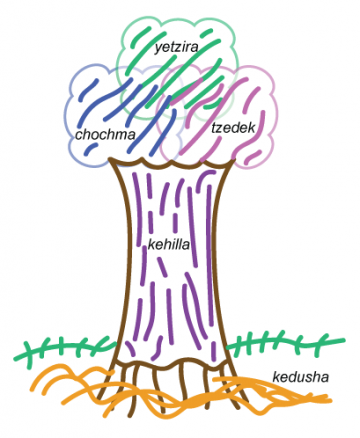
I originally thought that kedusha (Sacred Purpose) did not fit directly into Tkiya’s work but I then realized that our work is grounded and rooted there, giving us a basis on which to grow. Kehilla (community) is what we are continuing to build and grow through our work, branching off in all different directions for the many diverse communities that we serve. I picture the inner rings of the trunk building upon themselves, strengthening the foundation, and each branch is a new direction that we try, not yet knowing if it will grow to be a permanent part of the tree, will get overshadowed by another branch, or eventually fall off altogether. The leaves are different programs and experiences that we create on these branches. Any given program includes aspects of yetzira (creativity), tzedek (justice), and/or chochma (wisdom). Just as leaves fall off a tree and grow anew, we are constantly prototyping, adjusting, and giving new life to the experiences we share with our communities.
Carla Friend
Tkiyah: The Jewish Community Music Initiative
Brooklyn, NY
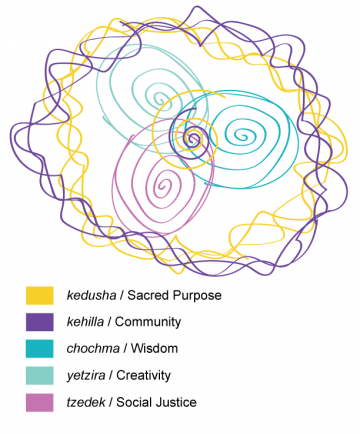
When thinking about the larger Jewish experience, for me, kedusha and kehillah are always linked. Judaism is lived in community by design and, being in a community – the connection to it, responsibility for it, and the joy of it – cannot be separated from each person’s sacred purpose on some level. To illustrate this, I have intertwined kedusha and kehillah and created a large ring with them to hold everything. Chochma, yetzira and tzedek are all central and all are all connected to each other as they are to kedusha and kehillah, so I created spirals for each of them that all intertwine together. I see kehillah and kedusha both as the container that holds everything as well as the central meaning/destination so I created an additional spiral of both of them in the center of tzedek, yetzira and chochma. Kedusha and kehillah hold everything together and also draw us into the center of ourselves and the community. Every element touches every other element because we are incomplete without all of them.
Stephanie Levin
Peninsula JCC
Foster City, CA
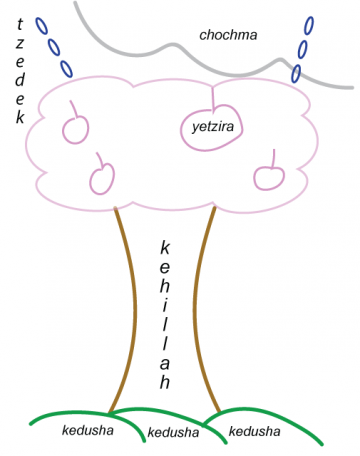
Everything is rooted in Holiness.
The tree trunk represents the Community, growing and strong.
The branches and fruits of the tree are the Creations of this Community. Clouds of Wisdom hover above, providing shade and moisture.
The Dew of Justice reaches into the branches and touches all Creation.
Naomi Malka
Adat Israel Community Mikvah
Washington D.C.

Perhaps the pillars form a kind of cyclical process:
- Chochma — Jewish wisdom and values — give us the shared foundation upon which we can build community, holiness, and action;
- Kehillah — community — are the relationships we weave with those with whom we share values and shared resonance for particular articulations of Jewish wisdom, chochma;
- Kedusha — holiness. Once we are personally and communally inspired and imbued with resonant expressions of Jewish wisdom and have built strong relationships into a resilient web of community, kedusha – holiness can be felt at its deepest level through ritual, prayer, Shabbat, holiday celebrations, etc. Without real chochma and kehillah as the foundation, kedusha is felt at a more superficial level
- Tzedek — justice. Coming from a cup overfloweth perspective, once we have ritualized and sanctified and strengthened/bonded our community, we need to take the ultimate step in embodying our values as individuals and as a community by bringing justice into the world. We do this most effectively when we are acting with a sense of holy purpose, when we act collectively, and when we are deeply informed by Jewish wisdom.
- And we don’t stop with tzedek. Rather we continue the process of continually engaging in the Jewish learning process, building community, creating sanctity, and then acting towards justice in the world. An ongoing upward spiral, aspiring to greater heights at every level.
Jakir Manela
Pearlstone Jewish Retreat Center
Reisterstown, MD
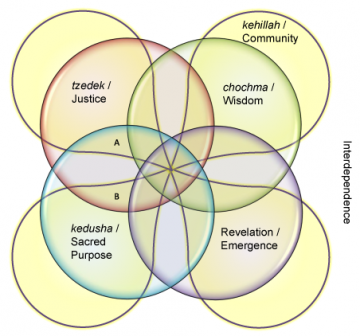
Since we have direct relationship to
Having “community” completely surround the three circles (in the current “official” iteration) implies to me that the inner three concepts only manifest in community, or that community is the sole focus of Kenissa (excluding nonprofits other than communities, of which there are many, and many here). So rather than community being a circle, it is here drawn as a flower — to note that some legacy and new communities have nothing to do with tzedek, chochma, or kedusha (to use only the three categories of the original sketch), and some portion of these three have existence outside of — but next to — community.
Some intersections show up in more than one place — for example, at the top of the diagram, I’ve labelled two spaces with a small “A” and “B.” Each represents intersections between three areas: sacred purpose, justice, and community. Though each area represents legitimate expressions of that intersection, they are separate. This depicts and emphasizes that this combination legitimately occurs in entirely distinct ways.
This feature (noted in #4) applies to all intersections between all elements in the diagram — each intersection of 2, 3, or 4 elements, as well as each individual element. The white space outside of the diagram represents interdependence, as this world and this work must exist in the duality between independence and interdependence. This white space would better be depicted by a presence (perhaps radiating lines) rather than the current white space.
Rev. John Millspaugh
Better Food Foundation/Jewish Initiative for Animals
San Diego, CA

I started with Justice and Creativity. Those are the driving forces of my approach to building community. Once community is established, we can begin the work of digging into collective wisdom. The deeper we dig, the closer we get to finding our sacred purpose and determine what art we can make to express what we’ve discovered through the journey.
Jon Adam Ross
The In(heir)itance Project
New York, NY
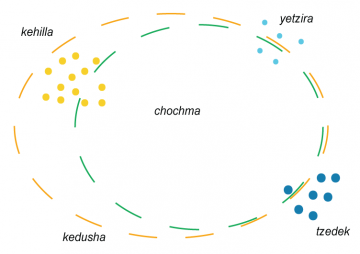
The drawing is both what I think what we should be and what we are. We are first and foremost a community with a shared narrative and a sense of mutual responsibility (kehillah). I meant to make circles all around the page, not just the top left.
Jewish wisdom is foundational to who we are. Our Torah, our shared narrative is based on the stories we tell each other year after year, week after week. Our interpretation of Jewish historical events and milestones denote what we think we ought to do or believe. (For example, we say that the destruction of the Temple was due to baseless hatred, which means we need to commit ourselves achdut. We tell the story of tanur shel achnai (Achnai’s oven, a famous Talmudic story, because we want to believe in a Judaism that empowers the people close to the Torah to define our way of life. Not a voice from Heaven etc.)
Kehillah and chochma creates kedusha, a sacred purpose. You can’t have kedusha without kehillah or chochma. Yetzira, the creative side to Jewish life, is sometimes in sync or inspired by communal values and wisdom; sometimes it sits outside of it. That’s a good thing. Art and creativity should challenge communal norms and conventional wisdom. Sometimes yetzira enhances kehillah and kedusha.
Tzedek is sometimes inspired by Jewish wisdom and communal responsibilities. However, a significant portion of the tzedek work is done by Jews because we think it is the right thing to do and we therefore attempt to make a bridge into kedusha, kehillah and chochma. Ideally, we would have more tzedek circles inside chochma, kehillah and kedusha. We grow our community of Jews who are motivated to justice work because they were first immersed in kedusha and chochma (not vice versa.)
Irene Lehrer Sandalow
Sketchpad
Chicago, IL
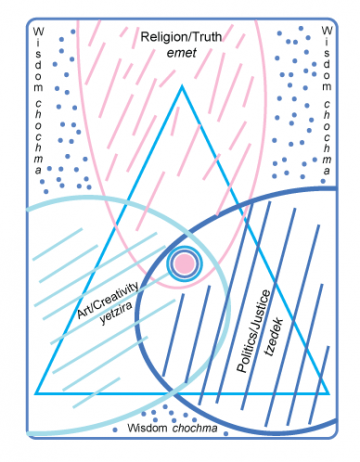
The diagram is centered on a triangle: Religion/Truth – Politics/Justice – Art/Creativity, corresponding to their deeper elements in Judaism: emet–tzedek–yetzira. While each of the elements can exist in its own right, they often overlap, reflect and enhance each other. The most potent and holistic spot, which I believe many of us aim at, is the eye in the middle, where the three overlap and co-exist. The triangle is contained within the rectangle of wisdom / chochma, a backdrop for the three elements, which finds expression through them. In the School for Creative Judaism, for example, learning is the vessel through which religion, art and politics are explored and expressed.
Misha Shulman
School for Creative Judaism
Brooklyn, NY
2018 Gallery of graphic representations of North American Jewish life by Kenissa Network members
Scroll forward to see all of the diagrams


